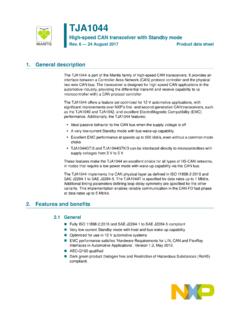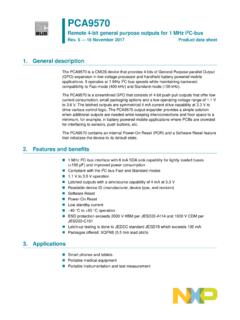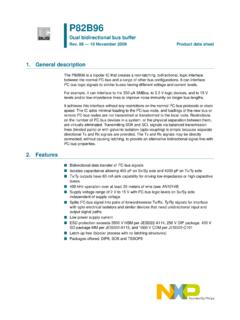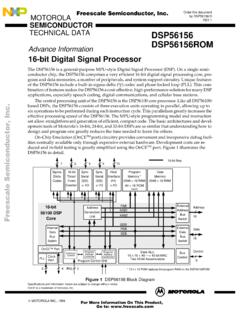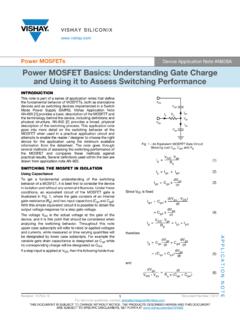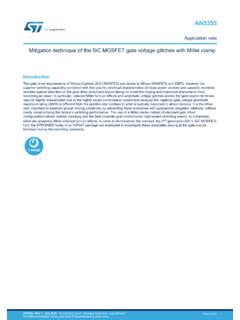Transcription of TJA1021 - NXP
1 1. General descriptionThe TJA1021 is the interface between the Local Interconnect Network (LIN) master/slave protocol controller and the physical bus in a LIN. It is primarily intended for in-vehicle sub-networks using baud rates from 1 kBd up to 20 kBd (/20 variant) and is compliant with LIN , LIN , LIN , LIN , SAE J2602 and ISO 17987-4:2016 (12 V). The TJA1021 is pin-to-pin compatible with the TJA1020 and MC33662(B).The transmit data stream of the protocol controller at the transmit data input (TXD) is converted by the TJA1021 into a bus signal with optimized slew rate and wave shaping to minimize ElectroMagnetic Emission (EME).
2 The LIN bus output pin is pulled HIGH via an internal termination resistor. For a master application, an external resistor in series with a diode should be connected between pin INH or pin VBAT and pin LIN. The receiver detects the data stream at the LIN bus input pin and transfers it via pin RXD to the Sleep mode, the power consumption of the TJA1021 is very low. In failure modes, the power consumption is reduced to a Features and General LIN 17987-4:2016 (12 V)/SAE J2602 compliant Baud rate up to 20 kBd (/20 variant) Very low ElectroMagnetic Emission (EME) High ElectroMagnetic Immunity (EMI) Passive behavior in unpowered state Input levels compatible with V and 5 V devices Integrated termination resistor for LIN slave applications Wake-up source recognition (local or remote) K-line compatible Pin-to-pin compatible with TJA1020 and MC33662(B) Available in SO8 and HVSON8 packages Leadless HVSON8 package ( mm mm) with low thermal resistance supporting Automated Optical Inspection (AOI)
3 Low power management Very low current consumption in Sleep mode with local and remote wake-upTJA1021 ISO 17987/LIN J2602 transceiverRev. 8 18 December 2018 Product data sheetTJA1021 All information provided in this document is subject to legal disclaimers. NXP 2018. All rights data sheetRev. 8 18 December 2018 2 of 25 NXP SemiconductorsTJA1021 ISO 17987/LIN J2602 Protection mechanisms High ESD robustness: 6 kV according to IEC 61000-4-2 for pins LIN, VBAT and WAKE_N Transmit data (TXD) dominant time-out function Bus terminal and battery pin protected against transients in the automotive environment (ISO 7637) Bus terminal short-circuit proof to battery and ground Thermally protected3.
4 Quick reference data 4. Ordering information [1] TJA1021T/10 and TJA1021TK/10: for the low slope version that supports baud rates up to kBd (SAE J2602);TJA1021T/20 and TJA1021TK/20: for the normal slope version that supports baud rates up to 20 1. Quick reference dataSymbolParameterConditionsMinTypMaxUn itVBAT battery supply voltagelimiting value with respect to GND -+40 VIBAT battery supply currentSleep mode; VLIN=VBAT;VWAKE_N=VBAT VTXD= 0 V; VSLP_N = 0 V2710 AStandby mode; bus recessive VINH=VBAT;VLIN= VBAT; VWAKE_N=VBAT VTXD= 0 V; VSLP_N = 0 V150 450 1000 AStandby mode; bus dominantVBAT = 12 V; VINH= 12 V; VLIN = 0 V VWAKE_N=12V; VTXD= 0 V; VSLP_N = 0 V300 800 1200 ANormal mode; bus recessive VINH = VBAT; VLIN= VBAT; VWAKE_N=VBAT VTXD=5V;VSLP_N = 5 V300 800 1600 ANormal mode.
5 Bus dominant VBAT=12V;VINH= 12 V; VWAKE_N=12V VTXD= 0 V; VSLP_N = 5 V124mAVLIN voltage on pin LINlimiting value with respect to GND, VBAT and VWAKE_N 40 -+40 VTvjvirtual junction temperature limiting value 40 -+150 CTable 2. Ordering informationType number[1]PackageNameDescriptionVersionTJ A1021T/10 TJA1021T/20SO8plastic small outline package; 8 leads; body width mmSOT96-1 TJA1021TK/10 TJA1021TK/20 HVSON8 plastic thermal enhanced very thin small outline package; no leads; 8 terminals; body 3 3 mmSOT782-1 TJA1021 All information provided in this document is subject to legal disclaimers.
6 NXP 2018. All rights data sheetRev. 8 18 December 2018 3 of 25 NXP SemiconductorsTJA1021 ISO 17987/LIN J2602 transceiver5. Block diagram Fig 1. Block diagramFILTERRXD/ INTBUS TIMERCONTROLTJA1021 WAKE-UP TIMERWAKE_NVBATSLP_NTXDRXDINHLINGND001aa e066 SLEEP/ NORMAL TIMER73241658 TEMPERATURE PROTECTIONTXD TIME-OUT TIMERTJA1021 All information provided in this document is subject to legal disclaimers. NXP 2018. All rights data sheetRev. 8 18 December 2018 4 of 25 NXP SemiconductorsTJA1021 ISO 17987/LIN J2602 transceiver6. Pinning Pinning Pin description [1] For enhanced thermal and electrical performance, solder the exposed center pad of the HVSON8 package to board TJA1021T/10; TJA1021T/20: ; TJA1021TK/20: HVSON8 Fig 2.
7 Pin configuration diagramsTJA1021 TRXDINHSLP_NVBATWAKE_NLINTXDGND015aaa231 12346587 TXD4 WAKE_N3 SLP_N2 RXD1 GND5 LIN6 VBAT7 INH8aaa-032606 TJA1021 TKterminal 1index areaTransparent top viewTable 3. Pin descriptionSymbolPinDescriptionRXD1recei ve data output (open-drain); active LOW after a wake-up eventSLP_N2sleep control input (active LOW); controls inhibit output; resets wake-up source flag on TXD and wake-up request on RXDWAKE_N3local wake-up input (active LOW); negative edge triggeredTXD4transmit data input; active LOW output after a local wake-up eventGND5[1]groundLIN6 LIN bus line input/outputVBAT7battery supply voltageINH8battery related inhibit output for controlling an external voltage regulator.
8 Active HIGH after a wake-up eventTJA1021 All information provided in this document is subject to legal disclaimers. NXP 2018. All rights data sheetRev. 8 18 December 2018 5 of 25 NXP SemiconductorsTJA1021 ISO 17987/LIN J2602 transceiver7. Functional descriptionThe TJA1021 is the interface between the LIN master/slave protocol controller and the physical bus in a Local Interconnect Network (LIN). The TJA1021 is LIN , LIN , LIN , LIN , SAE J2602 and ISO 17987-4:2016 (12 V) compliant and provides optimum ElectroMagnetic Compatibility (EMC) performance due to wave shaping of the LIN LIN physical layer is independent of higher OSI model layers ( , the LIN protocol).
9 Consequently, nodes containing an ISO 17987-compliant physical layer can be combined, without restriction, with LIN physical layer nodes that comply with earlier revisions (LIN , LIN , LIN , LIN , LIN , LIN , LIN and LIN ).The TJA1021T/20 and TJA1021TK/20 are optimized for the maximum specified LIN transmission speed of 20 kBd; the TJA1021T/10 and TJA1021TK/10 are optimized for the LIN transmission speed of kBd as specified by the SAE Operating modesThe TJA1021 supports modes for normal operation (Normal mode), power-up (Power-on mode) and very-low-power operation (Sleep mode).
10 An intermediate wake-up mode between Sleep and Normal modes is also supported (Standby mode). Figure 3 shows the state diagram. [1] Standby mode is entered automatically upon any local or remote wake-up event during Sleep mode. Pin INH and the 30 k termination resistor at pin LIN are switched on.[2] The internal wake-up source flag (set if a local wake-up did occur and fed to pin TXD) will be reset after a positive edge on pin SLP_N.[3] The wake-up interrupt (on pin RXD) is released after a positive edge on pin SLP_N.[4] Normal mode is entered after a positive edge on SLP_N.


